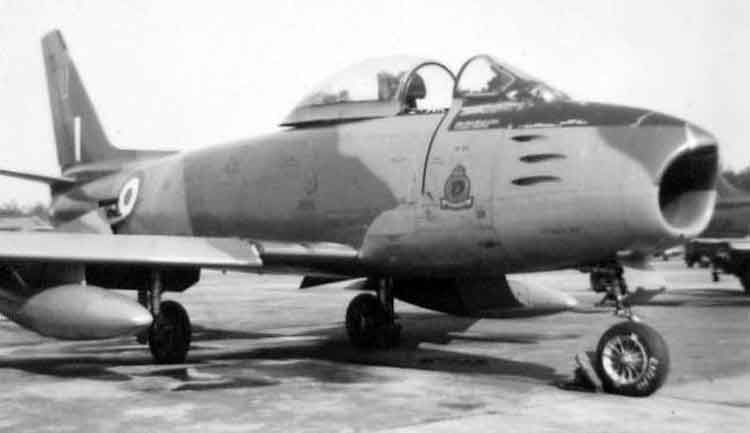 |
 |
 |

|
Sabre F.4 from the Sabre Conversion Unit - Mar54. SCU was located at Wildenrath, Germany. The following description of Wildenwrath is taken from Tony Fairburn's excellent book "Action stations overseas: Britain's military airfields abroad." It was sent to the web site by Tony Pearce.
Wildenrath, Germany: The first of the so-called 'Clutch' stations to be built (i.e. those close to the Dutch border - the other two being Bruggen and Laarbruch) Wildenrath was opened on 15 January 1952. Its role initially was to be that of fighter base, and in April two squadrons of Vampire FB5s moved in. These were Nos 3 and 71, and they were followed a month later by a third Vampire squadron, No 67, known collectively as 137 Wing.
 The Vampires, however, were no match for the impressive MiGs facing them across the 'Iron Curtain', and in the absence of a comparable contemporary British-produced interceptor all three squadrons were re-equipped with Canadian-built North American Sabres as a stop-gap measure in 1953. In order to train RAF pilots for the new fighter in Germany as a whole, a Sabre Conversion Flight was first formed, the initial six aircraft for the Flight arriving at
the end of March. The squadrons then began re-equipping with Sabres in May. The Sabre Conversion Flight was later retitled Sabre Conversion Unit and by the time it had completed its task and disbanded in June 1954 some 353 pilots had been converted, with only one serious accident. Number 3 Sqn transferred to Geilenkirchen in July 1953, but Nos 67 and 71 remained here until they both moved to Bruggen in July 1955. The Vampires, however, were no match for the impressive MiGs facing them across the 'Iron Curtain', and in the absence of a comparable contemporary British-produced interceptor all three squadrons were re-equipped with Canadian-built North American Sabres as a stop-gap measure in 1953. In order to train RAF pilots for the new fighter in Germany as a whole, a Sabre Conversion Flight was first formed, the initial six aircraft for the Flight arriving at
the end of March. The squadrons then began re-equipping with Sabres in May. The Sabre Conversion Flight was later retitled Sabre Conversion Unit and by the time it had completed its task and disbanded in June 1954 some 353 pilots had been converted, with only one serious accident. Number 3 Sqn transferred to Geilenkirchen in July 1953, but Nos 67 and 71 remained here until they both moved to Bruggen in July 1955.
 The 2nd TAF Communications Sqn had first appeared on the books with Ansons in December 1954, carrying VIPs and other personnel to all parts of the Continent and to the UK. By mid-1955 it was operating the Anson (Mks 12, 19 and 21), Valetta, Devon, Prentice and Vampire (FB5 and T11). The 2nd TAF Communications Sqn had first appeared on the books with Ansons in December 1954, carrying VIPs and other personnel to all parts of the Continent and to the UK. By mid-1955 it was operating the Anson (Mks 12, 19 and 21), Valetta, Devon, Prentice and Vampire (FB5 and T11).
 Nineteen fifty six saw the start of the Canberra era, with 88 Sqn reforming in January on B(I)8s, the first RAF squadron to equip with this mark of Canberra, with its distinctive off-set fighter canopy and belly-mounted gun pack capable of housing 20 mm or 30 mm cannon. Initially operating in the day and night interdictor role, the Canberra B(I)8 units as a whole were also given a low level attack role. (Thanks to Ron Gray and Tony Pearce.) Nineteen fifty six saw the start of the Canberra era, with 88 Sqn reforming in January on B(I)8s, the first RAF squadron to equip with this mark of Canberra, with its distinctive off-set fighter canopy and belly-mounted gun pack capable of housing 20 mm or 30 mm cannon. Initially operating in the day and night interdictor role, the Canberra B(I)8 units as a whole were also given a low level attack role. (Thanks to Ron Gray and Tony Pearce.) |
 |
 |
 |
|
